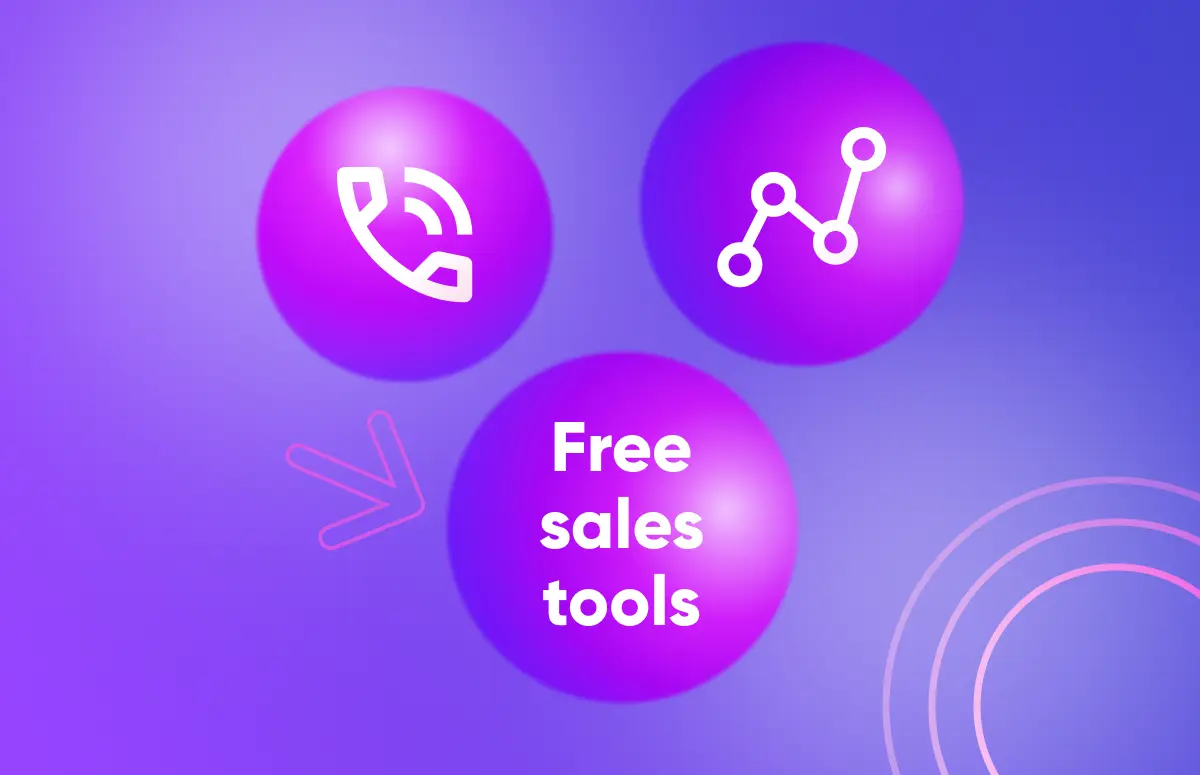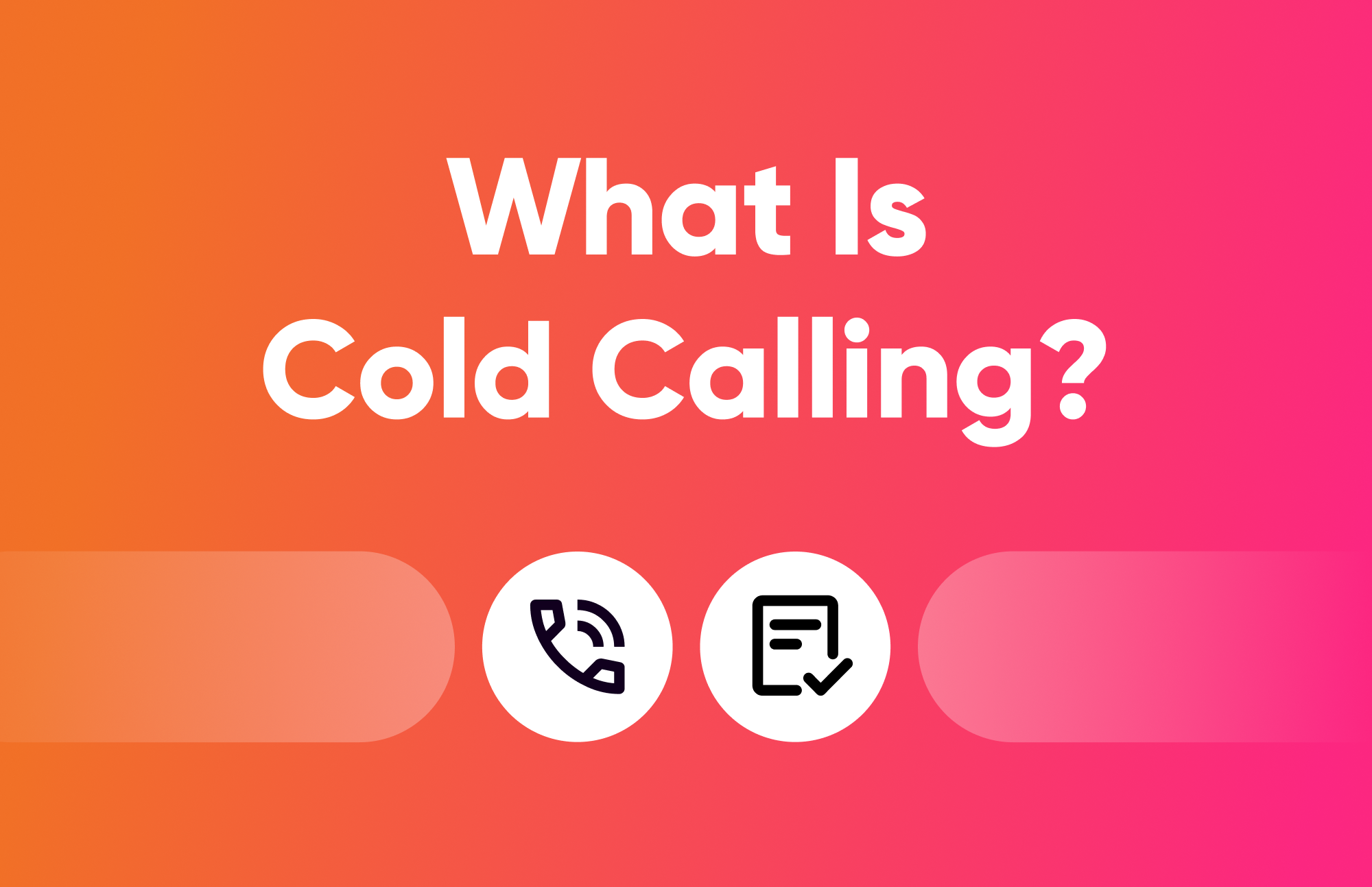
8 steps for a winning sales strategy
Your business has a game-changing product. It’s different and effective. You know it’ll stand out from the crowd. 💫
So, the next question is, how do you ensure your outbound sales team can successfully sell everything it offers?
The answer is: Develop a sales strategy that can generate leads, answer questions from prospects, and close more sales.
Below we’ll get into creating an effective sales strategy for the long haul.
What is a sales strategy?
A sales strategy is your business’s plan to maximize product or service sales.
This strategy uses principles based on a company’s competitive advantage to gain new customers. As well as growing their current ones.
It doesn’t matter whether your sales team is 5 or 500 employees; having an effective strategy is necessary. Without it, your team will struggle to fill the sales pipeline and close deals quickly.
A sales strategy is a documented plan for outbound sales revenue in the short and long term. It also maps out how you will differentiate your product from competitors.
Your sales team should use it as a guide to set themselves up for success. 🏆
When developing a sales strategy, ensure it aligns with other elements like your target market. For example, details of your ideal customer profile (ICP) and buyer persona. Not to mention sales motions, go-to-market positioning, and other components.
Your strategy should help your team determine your potential customer’s pain points. And how the product or service will solve them. Remember that you may need to evolve and change your inbound and outbound sales strategy as the business grows!
Inbound vs. outbound sales strategies
There’s an age-old debate over which is ‘better’. The truth is both are valuable, but it largely depends on what you’re selling. Some businesses may cope without a big outbound sales function, for example, product-led growth (PLG) software companies.
- Inbound sales: This is about letting your customers come to you. They seek you out from the demand you create through various channels. Usually, their interest is captured in a form on your website.
- Outbound sales: This is where SDRs actively seek out opportunities. The prospect might not even know about your solution yet. Outbound sales mean you can capture a large segment of the market that might not be openly looking to buy but would be open to it if someone were to educate them about other options.
The importance of a clearly defined sales strategy
This doesn’t happen overnight. That’s why it’s so important that your team puts in the time and effort to build one. A defined sales strategy with clear and achievable metrics is crucial for the success of your sales team and the entire organization.
David Bentham, VP of Global Sales Development at Cognism explains more in the clip below. 🎬
Regardless of whether the strategy is through social selling or product-oriented selling. You need a defined approach to drive leads and build customer relationships.
Lead generation strategies allow your team to navigate the future better and assess problems. They should also allow you to manage approaches throughout the company.
The strategy should highlight:
- How you will sell across different platforms
- And, develop strategic partnerships with other businesses
Doing this will ensure that all sales reps are on the same page and understand how to use the strategy.
Effective sales strategies and styles for 2024
We know that buying behavior has changed dramatically over the last decade. Shabri Lakhani, Kaspr’s Subject Matter Expert, has over 13 years of sales leadership experience, and she says outbound is 4x harder today than it used to be.
So now, let’s look at some of the effective sales strategies for today’s market.
Value-based selling
The days of quantity over quality are over. 🫡
There are many places where prospects look for information now; digital channels mean they don’t have to speak to a rep. Value-based selling is where SDRs aim to add more value to the buying process than any other available channel can.
Core characteristics of value-led selling include:
- Actively looking for prospects that aren’t in the market to buy right now.
- Adding quality prospects to the pipeline.
- Sending hyper-personalized outreach.
- Following up regularly with prospects.
- Reps position themselves as experts.
PACTT and SPIN selling
PACTT and SPIN selling are frameworks reps can use to help implement value-based selling and other sales strategies.
PACTT stands for:
- Pain - What your prospects challenges are.
- Authority - How much buy-in you have in the account (multi-threading stakeholders).
- Consequence - The pain point the solution will solve if it’s bought.
- Target profile - Considers prospects that might not be ready to buy yet.
- Timing - Looks at the budget cycle, annual plans or end-of-year.
Shabri Lakhani explains why she prefers PACTT over another commonly referenced framework, BANT (budget, authority, need, timing):
“I like PACTT because the ‘P’ stands for pain, whereas the ‘N’ in BANT stands for need, but often, when doing outbound sales, there is no immediate need. The pain element allows sales reps to uncover whether there might be a challenge the prospecting is facing that they are not yet aware of.”
SPIN selling stands for:
- Situation - What is the prospects current situation?
- Problem - Is there a specific problem that you can help solve for your prospect?
- Implication - What would the implementation of your product look like?
- Need-payoff - Is your product right and is the prospect ready to buy right now?
This approach also enables reps to lead with value. But one issue we do have with it is that unlike PACTT, it doesn’t actively consider those not in the market to buy right now. So what happens to them?
💡 Learn more about sales methods and types of selling to avoid .
Social selling
There are so many channels to connect with prospective customers now. And the relationship doesn’t even have to start with your sales scripts. Social selling is such an effective channel for reps. It almost goes hand-in-hand with your marketing strategies - SDRs become mini-marketers!
Tom Boston, Top Social Selling Voice on LinkedIn and Brand Awareness Manager at Salesloft has made a career out of creating a personal brand. He’s the host of a podcast (No Nonsense Sales) and creates lots of sales content for Salesloft too.
But here’s the thing, Tom started out at Salesloft as an SDR. During his time as a rep, he created loads of entertaining sales content to appeal to the ideal customer persona like this. 👇
The result of content like this that resonates with your audience, is that you build up an audience of people who know about your product and the problems it solves.
📹 Get more sales advice and prospecting tips from our FREE streaming service, prospecting on demand.
8 steps to develop a winning sales strategy
Ready to start creating a sales strategy to hit your more revenue targets?
Here’s what you need to do:
- Learn what is takes to attract your target customers.
- Could you add self-serve?
- Organize your sales team.
- Create your ideal customer profile.
- Be the guide for your prospects.
- Consider this when moving upmarket.
- Experiment with your sales strategy.
- Only use channel partners to accelerate growth.
1. Learn what it takes to attract your target customers
Step one is understanding how to attract your target customer 🎯
To do this, you’ll need to pinpoint the best way to reach these customers for the best possible outcome. Which is an increase in revenue.
For example, some leads will respond (and respond well) to outbound sales tactics like cold calls and cold emails. But others have a better chance of interacting with inbound tactics like content marketing about your product or service.
This is the classic inbound vs outbound sales debate. We summarize some of the key points to consider in the infographic below 👇
/Inbound%20vs.%20outbound%20sales%20infographic/EN_infographic-inbound-vs-outbound-sales.webp?width=600&height=1012&name=EN_infographic-inbound-vs-outbound-sales.webp)
When you know which direction will better attract customers, your sales team can move towards those efforts and fine-tune them for the utmost success.
2. Could you add self-serve?
This next step boils down to your average contract value. It may be challenging to have outbound sales in the equation if it’s on the lower end, like $1,000 for the year.
But, if your team deals with a complex sale with a long sales cycle. For example, one that lasts longer than 20 or 30 days, with a sales cadence involving two or three calls with more than one person, sales is a must in a self-serve model.
Education and automation only go so far, at some point, your customers will want to talk to a sales rep.
3. Organize your sales team
When you build your sales team, it should start with establishing clear and differentiated roles for every sales rep.
Create a list of attributes and responsibilities for sales managers to screen for. This will help them when they interview candidates for specific roles.
Then, once you’ve hired the top talent for these roles, you can train and onboard them to sell efficiently and effectively. As you build a sales strategy, be specific about creating the right roles on your team. Make sure you prioritize the right skills within each role.
For example, what’s defined for inbound sales reps will be different for outbound sales reps.
Inbound sales reps will need skills focusing on top-of-the-funnel trends. Such as aligning with the marketing team and using social media to bring in qualified leads.
Meanwhile, the outbound sales team will focus on mastering the art of cold calling.
Elric Legloire, SDR Manager at Agorapulse recently told us he looks for these characteristics when hiring sales reps:
- Taking ownership - Team members must drive initiatives, create sequences, and do A/B testing. Shared ownership accelerates team growth.
- Adaptability - Moving from a big to a small company requires adapting to different processes and roles. It’s about thriving in a dynamic, process-light environment.
- Coachability - A team that welcomes and applies feedback swiftly is invaluable. The ability to adapt processes based on feedback is key to sustained success.
Elric is building out the team and processes at Agorapulse from scratch so this is an important part of his sales strategy plan!
4. Create your ideal customer profile
The next step is all about establishing your ideal customer profile (ICP). Your team needs to create a detailed profile of the customer.
This means looking at:
- Company size - often determines their budget and revenue, therefore how much they must spend on your product or service
- Industry - is your product or service industry specific?
- Geography - where can you do business?
- Legality - are there legal requirements that your company or the company you do business with must meet?
- Service level agreements (SLAs) - can you guarantee you’ll be able to meet the needs of your customer if they have these thresholds?
Use your ICP as a guide for your sales reps. It should help them focus on prospects who will convert and deliver repeat business.
5. Be the guide for your prospects
It’s in your team’s best interest to act like an advisor to your prospects. Always offer a free demo of the product or service so prospects can see what is being offered in action.
It’s up to your team to field questions and be ready with helpful answers. Sales reps need to find out more about their prospects, too. Learn exactly how a prospect intends to use your product and tailor the demo to their needs.
Educate your sales team so that your prospects can learn the ins and outs of the product from them. Tell the product's story from the prospect's perspective and their business. And always follow up.
6. Consider this before moving upmarket
Growth within a business is an exciting time. One day you’re a startup and it can feel as if you blink and become a mature organization.
Growth can look like many different things. But make sure your team stays deliberate as your business moves upmarket and begins to sell to bigger organizations.
This means, not everything has to change as a company scales. The simplicity of your sales strategy can still be effective. After all, it likely is what allowed your business to grow in the first place.
7. Experiment with your sales strategy
A sales strategy isn’t a “set it and forget it” type of process. Your team will likely come up with new ideas or tactics as they encounter more prospects.
Implementing too many ideas at once can turn your sales team on its head. When your team experiments with the sales strategy, have them start small with one or two ideas at a time.
Experiment with ideas before you unleash a full-scale pivot on your team. Pivoting before an idea is truly tested will only cause disruption.
8. Only use channel partners to accelerate growth
When developing your sales strategy, it can be tempting to leverage channel partners to help establish growth.
But don’t move too fast. Hold off on using channel partners until you need to accelerate growth, not create it. Especially if your company is just starting out.
But what is a channel partner? They’re a company that partners with you to market or sell your products and services. For example, a reseller, vendor or agent.
If you’re a startup, you need to be smart. It’s best to have a steady stream of customers and monthly revenue before you turn to channel partners.
Once you do, channel partners will help take growth to the next level, but they won’t build it from the ground up.
So when is the best time to bring in channel partners?
- When your company has a product that is gaining traction with customers.
- When you’ve found success with both inbound and outbound sales.
- When you have a good flow of revenue.
Final thoughts
Rome wasn’t built in a day, and neither was a successful sales strategy.
But don’t forget. When you invest time and effort to develop a sales strategy, you’re investing in your company as a whole.
Here are our final thoughts on developing a sales strategy:
- No matter if your sales team is 12 people or 120 people, having a sales strategy is an absolute must.
- Be patient, a sales strategy that works takes time.
- Know what makes your customers tick and tailor your product and sales technique to them.
- Your team is only as strong as your reps, hire and onboard effectively!
Accurate European contact data
Get accurate data for your prospects and connect with your favorite sales tool







![15 Best Sales Cadence Software For 2025 [Compared]-festured-image](https://6052405.fs1.hubspotusercontent-na1.net/hubfs/6052405/2023%20-%20Blog/EN%20SEO%20blogs%20%28Clusters%29%20%5B%2B%20FR%2c%20ES%20and%20DE%20variations%5D/Outbound%20sales%20%28cluster%29/Sales%20cadence%20software/EN_sales-cadence-software-card.png)
